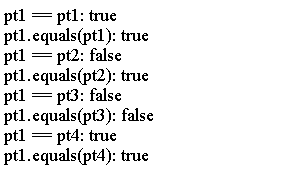惠州Java Object.Equals方法是什么?_北大青鸟IT计算机学校
作者:邓华发布时间:2021-03-31分类:Java技术浏览:834
之前惠州北大青鸟老师给大家分享了很多关于Java面向对象设计的知识,下面我们一起来学习一下Java Object.Equals方法。
以下代码显示如何实现equals()和hashCode()方法
class Point { private int x; private int y; public Point(int x, int y) {
this.x = x;
this.y = y;
} /* implement the equals() method */
public boolean equals(Object otherObject) { // Are the same? if (this == otherObject) { return true;
} // Is otherObject a null reference? if (otherObject == null) { return false;
} // Do they belong to the same class? if (this.getClass() != otherObject.getClass()) { return false;
} // Get the reference of otherObject in a SmartPoint variable Point otherPoint = (Point) otherObject; // Do they have the same x and y co-ordinates boolean isSamePoint = (this.x == otherPoint.x && this.y == otherPoint.y); return isSamePoint;
} /*
* implement hashCode() method of the Object class, which is a requirement
* when you implement equals() method
*/
public int hashCode() { return (this.x + this.y);
}
}public class Main { public static void main(String[] args) {
Point pt1 = new Point(10, 10);
Point pt2 = new Point(10, 10);
Point pt3 = new Point(12, 19);
Point pt4 = pt1;
System.out.println("pt1 == pt1: " + (pt1 == pt1));
System.out.println("pt1.equals(pt1): " + pt1.equals(pt1));
System.out.println("pt1 == pt2: " + (pt1 == pt2));
System.out.println("pt1.equals(pt2): " + pt1.equals(pt2));
System.out.println("pt1 == pt3: " + (pt1 == pt3));
System.out.println("pt1.equals(pt3): " + pt1.equals(pt3));
System.out.println("pt1 == pt4: " + (pt1 == pt4));
System.out.println("pt1.equals(pt4): " + pt1.equals(pt4));
}
}
上面的代码生成以下结果。

注意
这里是equals()方法的实现的规范。假设x,y和z是三个对象的非空引用。
自反性。表达式x.equals(x)应该返回true。
对称性。如果x.equals(y)返回true,y.equals(x)必须返回true。
传递性。如果x.equals(y)返回true,y.equals(z)返回true,则x.equals(z)必须返回true。
一致性。如果x.equals(y)返回true,它应该保持返回true,直到x或y的状态被修改。如果x.equals(y)返回false,它应该保持返回false,直到x或y的状态被修改。
与空引用的比较:任何类的对象不应等于空引用。表达式x.equals(null)应始终返回false。
与hashCode()方法的关系:如果x.equals(y)返回true,x.hashCode()必须返回与y.hashCode()相同的值。
更多Java资讯关注网站动态,或者来惠州北大青鸟新方舟校区了解一下。
标签:惠州计算机JAVA软件开发惠州计算机Java软件开发惠州计算机JAVA培训惠州计算机JAVA软件开发学校惠州计算机Java软件开发培训JAVAJava软件开发北大青鸟IT计算机学校北大青鸟IT软件学校北大青鸟IT学校
- Java技术排行
- 标签列表
-
- Java (3694)
- 北大青鸟 (3713)
- 软件开发 (3613)
- JAVA (3413)
- UI设计入门 (2093)
- 惠州北大青鸟 (4375)
- 惠州IT培训 (2558)
- UI设计培训 (2090)
- 惠州UI设计培训 (2095)
- 惠州UI设计培训学校 (2090)
- 惠州计算机软件培训 (6260)
- 惠州计算件软件开发 (6260)
- 惠州计算机软件基础 (6261)
- 惠州计算机JAVA培训 (3574)
- 惠州计算机Java软件开发 (3620)
- 惠州计算机JAVA软件开发 (4645)
- 惠州计算机JAVA软件开发学校 (3338)
- 惠州计算机Java软件开发培训 (3338)
- 北大青鸟IT计算机学校 (5048)
- 北大青鸟IT软件学校 (5062)
- 北大青鸟IT学校 (5059)
- 惠州计算机UI设计软件开发 (2088)
- UI设计基础教程 (2088)
- UI设计是什么 (2088)
- UI设计教程 (2088)
- 网站分类
-
- 计算机教程
- 计算机入门
- 职业学校
- 新闻动态
- 专业课程
- 热门技术
- SEO
- 培训教程
- windows
- linux教程
- 系统集成
- 网站开发
- Html5
- 办公软件
- 师资力量
- 热点问答
- 联系我们
- 计算机学校
- 惠州计算机学校
- 河源计算机学校
- 广州计算机学校
- 深圳计算机学校
- 湛江计算机学校
- 佛山计算机学校
- IT计算机培训信息
- 设计专业
- UI
- 影视特效
- 游戏动漫设计
- Photoshop
- AI设计
- 软件教程
- Java技术
- C语言/C++语言培训
- C#
- Python技术
- PHP
- 数据库
- SQL Server
- 网络教程
- 网络安全
- 网络营销
- 软件专业
- 大数据专业
- 前端开发专业
- 软件测试专业
- Python专业
- 软件实施
- 珠海计算机学校
- 初中生学什么好
- 计算机认证
- 文章归档
-
- 2024年5月 (36)
- 2024年4月 (80)
- 2024年3月 (65)
- 2024年2月 (54)
- 2024年1月 (25)
- 2023年12月 (12)
- 2023年11月 (73)
- 2023年10月 (134)
- 2023年9月 (34)
- 2023年8月 (3)
- 2023年7月 (3)
- 2023年6月 (12)
- 2023年5月 (30)
- 2023年4月 (72)
- 2023年3月 (11)
- 2023年2月 (34)
- 2023年1月 (37)
- 2022年12月 (78)
- 2022年11月 (359)
- 2022年6月 (1193)
- 2022年5月 (570)
- 2022年4月 (1567)
- 2022年3月 (982)
- 2022年2月 (54)
- 2022年1月 (182)
- 2021年9月 (308)
- 2021年8月 (1704)
- 2021年7月 (2423)
- 2021年6月 (1806)
- 2021年5月 (1569)
- 2021年4月 (1380)
- 2021年3月 (1255)
- 2021年2月 (709)
- 2021年1月 (1521)
- 2020年12月 (3626)
- 2020年11月 (1646)
- 2020年10月 (1046)
- 2020年9月 (592)
- 最近发表
-
- 汕尾信息:世界技能大赛获奖选手全省巡回宣讲交流活动走进汕尾|||电脑计算机编程培训学校
- 河源信息:世界技能大赛获奖选手到河源开展全省巡回宣讲交流活动|||广州市北大青鸟计算机职业培训学校
- 佛山信息:6000+“笋岗”!粤西专场招聘会!佛山名企→|||广州市北大青鸟计算机职业培训学校
- 江门信息:@创业培训讲师,快来参加广东省第二届马兰花创业培训讲师赛江门选拔赛|||电脑计算机编程培训学校
- 东莞信息:普法宣传进工地治欠保支暖民心|||中专学计算机平面设计女生可以学计算机网络技术好吗
- 佛山信息:奖金高达20万!“中国创翼”创业创新大赛报名|||计算机职业技能培训班
- 阳江信息:阳江市2024年“人社局长千企行”活动启动|||计算机网络培训学校
- 江门信息:江门选手斩获全国乡村振兴职业技能大赛铜牌,实现国赛奖牌“二度破冰”|||北大青鸟计算机培训中心
- 汕头信息:汕头高层次人才“金凤卡+社保卡”一站办理!赋能人才工作高质量发展|||北大青鸟计算机培训中心
- 东莞信息:沙田镇召开社保志愿推广会|||计算机培训学校招生


